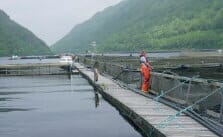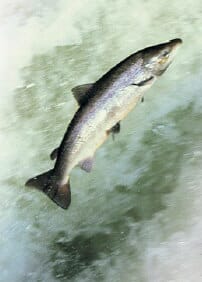The Atlantic salmon (Salmo salar) is the most important farmed fish species in the UK and a disappearing species in the wild. The idea behind the DNA chip is to take a snapshot of indicator biological processes within the fish, from small tissue samples. It is the culmination of a four-year, multi-centre study to identify the genetic basis of commercially important traits.
The project, known as Salmon TRAITS (TRanscriptome Analysis of Important Traits in Salmon), involves a number of industrial partners: Operon Biotechnologies, Marine Harvest and Scottish Quality Salmon, an organisation that represents the producers of 65% of Scottish farmed salmon.
The four most important constraints on commercial production are the supply of contaminant-free highly unsaturated oils, including omega-3s, for the salmon diet; the long and complex lifecycle; infectious disease; and protein growth efficiency, says Professor Alan Teale, lead researcher at the Institute of Aquaculture, University of Stirling. We have identified genes involved in polyunsaturated fatty acid metabolism, protein metabolism, bacterial and viral infection, and freshwater to seawater adaptation. Greater knowledge of these processes will help us to monitor the health, development and productivity of farmed and wild Atlantic salmon populations with a depth and precision that has not been possible previously.
Precision aquaculture
 Image courtesy of Jimmy Turnbull, University of Stirling |
The life cycle of the Atlantic salmon includes a number of dramatic physical and body chemistry changes that prepare the fish for the shift from a freshwater to a saltwater environment. In nature, this metamorphosis, known as smoltification, occurs during the Spring, and marks the start of a period of intense growth. However, with little known about the genetic control of smoltification, salmon farmers have had to rely on their own experience to predict the best time to move fish into saltwater cages get it wrong and the consequences can be serious.
It is difficult to tell when fish are ready to be moved. Farmers have to make a judgement based mainly on the appearance of the fish. Move them too early and the fish may not thrive, becoming stunted and eventually dying. While stress associated with premature transfer may leave them more vulnerable to infection, explains Dr Glen Sweeney, Cardiff University.
The Cardiff team has identified a number of genes that appear to be up-regulated during smoltification in tissues such as gill, brain, pituitary and kidney. The identification of these markers could be useful in determining the readiness of fish for saltwater transfer and would also provide a means of studying the effects of environmental pollutants on smoltification, says Dr Sweeney.
Diet and nutrition
 Image courtesy of Richard Collins, University of Stirling |
Highly unsaturated fatty acids (HUFA), including omega-3s, are essential nutrients, important for growth and development in all animals particularly for the normal functioning of cell membranes of the central nervous system. However, many species cannot produce active forms of these oils from plant oil sources effectively: they need ready made supplies. This is why oily marine fish are an important part of the human diet; wild salmon get most of their omega-3s through the marine food chain. The problem is that feeding fish to salmon, in order to supply them with omega-3s, is no longer sustainable and farmed salmon must become vegetarian for at least part of the production cycle, says Professor Teale.
Research in Stirling is focussed on the genes controlling synthesis of HUFA in salmon. Prof. Teale says, Being able to monitor the functioning of these genes in fish stocks will enable precision in dietary formulation and optimisation of feeding levels. It will also enable breeders to select for fish in which these genes are more active than in the majority of the population.
Studies of wild salmon populations may also prove revealing as HUFAs help nerve cells function across a wide temperature range. Prof Teale says, With climate change, freshwater streams where salmon parr live are getting warmer, but after smolting, when much of the UK wild salmon population moves into the North Atlantic and out to the Labrador Sea, they are faced with increasingly lower temperatures. We will not know until we do the research, but it is possible that these opposing natural selecting forces partly explain why wild stocks are in serious decline.
Disease prevention
Given the environment in which farmed fish are maintained, together with high stocking densities and handling issues, bacterial and viral pathogens, including a number of emerging diseases pose a difficult challenge for aquaculture. Poor health can often be hard to see: the first indication of a problem may be large numbers of dead fish. Prof Secombes group at the University of Aberdeen has analysed gene expression in fish tissue samples, following infection with different pathogens. Several hundred genes were found to be more or less active following a bacterial infection in salmon.
These genes have different roles in the immune response including bactericidal activity, acute phase response proteins and cytokines, explains Prof. Secombes. We have also studied the relationship between nutritional status and immune response and there are indications that the progression of an immune response may be affected by nutritional status.
With the large-scale gene expression analysis completed and performance indicators selected, the final stage of the project is to construct the DNA chip and confirm its suitability for use in the aquaculture industry and for wild salmon stocks.
November 2006


